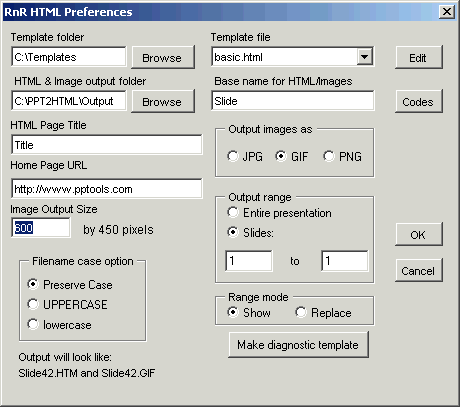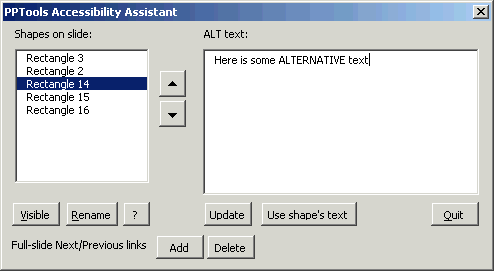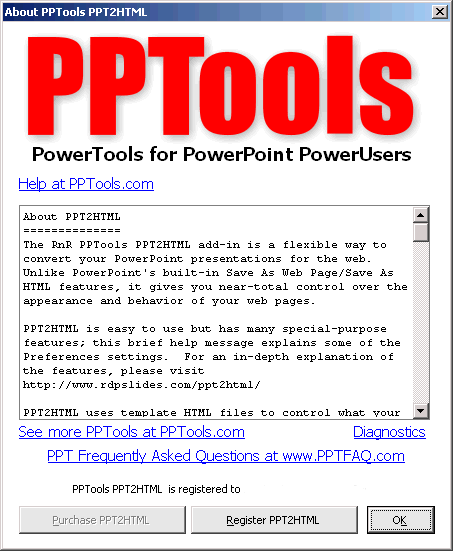PPT2HTML in Detail

The PPT2HTML Toolbar
PPT2HTML creates a toolbar that looks like this. It also adds a PPTools item to the main PowerPoint menu bar and under that a PPT2HTML item that leads to the same options we describe next. You can use either the toolbar or the menu, whichever you prefer.
A quick look at what each button does:
| Button | Name | What it does |
 |
PPT2HTML Preferences | Brings up the PPT2HTML Preferences dialog box, where you can set various options that control how PPT2HTML converts your presentations to HTML. See below for a full description. |
 |
Create HTML | Converts your presentation to HTML using the current settings. |
 |
Accessibility Assistant | Brings up the Accessibility Assistant, where you can set reading order, ALT text and several other features that will make your presentations more accessible. |
 |
PPT2HTML Help | Get Help with PPT2HTML |
Now let's look at each of these buttons in detail ...
| Icon | Name | From PPT menu bar |
 |
PPT2HTML Preferences | PPTools, PPT2HTML, PPT2HTML Preferences |

The PPT2HTML Preferences dialog box
Template Folder
By default, PPT2HTML's templates are stored in the PPTools folder but you can store your own templates wherever you like. Simply type the full path to the folder where they're stored in the Template Folder text box or click Browse and choose the folder you want.
Template file
Whenever you open the Preferences dialog or choose a new Template folder with the Browse button, PPT2HTML searches your chosen template folder for *.htm files and loads the names of any it finds into the Template File dropdown list box.
Choose the template you want to use from the list box.
Edit
Click Edit to edit or view the currently chosen template in Notepad.
Codes
Click Codes to see a list of all the special placeholders you can use in your templates.
HTML & Image output folder
This is the folder where you want PPT2HTML to store the HTML files and images it generates from your presentations. Type in the full path to the folder or click Browse and choose the folder you want to use.
Base name for HTML/Images
PPT2HTML creates a series of HTML and image files from your presentation, one HTML and image file per slide. It adds a sequential number to the end of the base name you type here.
For example, if you type: MyFile PPT2HTML will make files named:
MyFile1.HTM and MyFile1.GIF
MyFile2.HTM and MyFile2.GIF
MyFile3.HTM and MyFile3.GIF
and so on.
HTML Page Title
The Page Title is the text that appears in the browser's title bar when you view the HTML files PPT2HTML creates.
PPT2HTML adds (Page x) to what you type here, where X is the number of the slide/html file.
For this to work, you'll need to include:
<TITLE>:pagetitle:</TITLE>
in the HEAD section of your template file.
See TEMPLATE.HTM, included with PPT2HTML, for an example.
Home Page URL
Usually this should be the URL of your home page, but it can be any URL you like.
PPT2HTML will substitute whatever you type here when it encounters the http://www.pptools.com placeholder in your template file.
It will also create a link to this URL in imagemaps when it finds a HOME action setting on one of your PowerPoint slides.
Image Output Size
This enables you to set the width (in pixels) of the image files PPT2HTML generates from each slide it converts to HTML.
Note: if you plan to have PPT2HTML generate imagemaps for your slides, make sure that you specify the width of the image in your template in pixels AND that you specify the same width here or use :Slide.Image.width: in your template. Otherwise your imagemap coordinates will be wrong and the imagemap links will be in the wrong place (if they appear at all).
Example:
In your template file, specify:
:map:
<IMG SRC=":Slide.Image:" width=:Slide.Image.width:>
NOTE:
When you chage the Image Output width in the Preferences dialog, PPT2HTML calculates the image height; the resulting image will be proportional to the slide size of the presentation. This allows you to set any size you like for the slide images in your HTML and still be certain that the images will be perfectly proportional to your original PowerPoint slides.
Output images as
Pick the the image type, GIF, JPG or PNG, you want PPT2HTML to create.
JPG is best for slides that contain "photo" type images or other scans or slides that won't look good in only 256 colors.
GIF is best for slides that only need 256 colors and contain large areas of "flat" color.
PNG isn't supported by all browsers, but may be the best all-around choice for presentations that contain a mix of photos, scans and "flat" color graphics, so long as you know your viewers have newer browsers.
Output range
PPT2HTML can convert your entire presentation or just a range of slides.
If you convert just a range of slides, you can choose either Show or Replace as the Range Mode.
Show
Creates a show from a portion of your presentation.
It converts a subset of your presentation slides to a standalone web "show" with HTML files numbered from 1 to however many slides you chose to convert. For example, if you convert just slides 10 to 15 and choose Show mode, you'll get HTML files numbered from 1 to 6 made from slides 10 - 15 in your presentation.
From the point of view of the HTML version of the show, HTML file 1 is the first slide in the entire presentation, HTML file 6 is the last slide, no matter what the original slide numbers may have been in your original PowerPoint file. Any navigation links behave accordingly.
Replace
Useful for making corrections to a few slides out of a larger presentation.
It converts a range of slides but doesn't alter their numbers. Example: if you convert slides 10 to 15 and choose Replace, your HTML files will also be numbered 10 to 15.
Any links to the Previous slide on number 10 will link to number 9.
Replace can convert just the corrected slides rather than having to convert the entire presentation again.
Filename case option
Some web servers, notably those on Unix/Linux computers, are fussy about upper/lowercase letters in file names.
To a Windows or NT web server, ThisFile.htm, THISFILE.HTM and tHiSfIlE.hTm are all the same file, so links to any of those names will work.
On a Unix/Linux server, these would all be seen as different filenames. If you have ThisFile.htm on the server but the link points to THISFILE.HTM, you'll get error messages instead of web pages when you click the link.
The Filename case options let you control what PPT2HTML does with your filenames.
Preserve means Don't Change Anything. Leaves the base name EXACTLY as you typed it.
UPPER means make the names UPPERCASE
Lower means Make the names lowercase
Make diagnostic template
Creates a special template that exercises all of PPT2HTML's features. For more info, see Which placeholder does what? Show me!
Output will look like
As you change the various Filename options, the text here changes to reflect the options you've selected and give you an idea of what your output HTML and image filenames will look like.
The range of slides you've elected to convert is not reflected here. Instead, it simply shows a specimen HTML/image pair from an imaginary Slide 42. Those of you who know the meaning of Life, The Universe and Everything will see the irrefutable logic in this. You know who you are (and you probably know where your towel is). If this makes no sense to you at all, Don't Panic. 42 is probably the wrong answer anyway. Your HTML files will get reasonable numbers. Trust us.
| Icon | Name | From PPT menu bar |
 |
Create HTML | PPTools, PPT2HTML, Create HTML |
Create HTML does just what it says it'll do. Click it to create HTML from your presentation using the current PPT2HTML settings from the Prefs dialog box.
You'll see a summary of the options you've chosen and you'll have a chance to cancel if they're not set the way you expected.
| Icon | Name | From PPT menu bar |
 |
Accessibility Assistant | PPTools, PPT2HTML, Accessibility Assistant |

The PPT2HTML Accessibility Assistant
The Accessibility Assistant is a new addition to PPT2HTML. It helps you change your slides so they're more accessible to people with visual and other disabilities. You can do most of this stuff in PowerPoint itself, but it requires you to burrow through lots of menus and dialog boxes. The Accessibility Assistant brings all the important features you'll need out to the front and onto one easy-to-use dialog box.
To learn more about accessibility, PLEASE read Glenna Shaw's excellent accessibility articles , especially The Incredible, Accessible Presentation
A few minutes with Glenna is all it takes to understand that this accessibility stuff is not just The Right Thing To Do ... it's really pretty easy.
Shapes on slide: shows you a list of all the shapes on the current slide, in the order that they appear on the slide. To change the order, select a shape by clicking its name, then use the up and down arrowhead buttons to the right (or the keyboard commands U and D) to move it up or down in the "stacking order".
When a screenreader reads text from a PowerPoint slide or an HTML version of one, it reads the text in the order that you've added it to the slide, not left to right, top to bottom. Use Shapes on slide: to assign the correct reading order to the shapes on your slides.
Note: when you click a shape, Accessibility Assistant selects it in PowerPoint so you can see which shape you're working with. Sometimes those names aren't too helpful. Of course, that's why there's ...
Rename
Select a shape, click Rename and give the shape a new name that makes more sense to you. "Boss" is so much easier to pick out of a list of shapes than "Rectangle 13".
Visible
You can turn a shape invisible or make it visible again with the Visible button. Even though the shape is invisible, it still appears in the Shapes on slide: list, so you can easily select it later.
Full-slide Next/Previous links - Add and Delete
Click Add to add a pair of invisible rectangles that fill each slide (one rectangle fills the left half of the slide and one fills the right half). These rectangles are assigned a Previous Slide and Next Slide action setting respectively. This means that a viewer can click anywhere on the left or right half of the slide to navigate your presentation, which can make your presentation much more accessible to people with small motor control problems or similar.
ALT text:, Update and Use shape's text
Addin ALT (alternative) text can go a long way toward making your graphics, pictures, charts and other visuals more accessible to screen reader users. The ALT text is frequently the only way they can get an idea what's in your graphics.
Select a shape in the Shapes on slide: list, then enter suitable descriptive text for it in the ALT text: box. If the shape already has text that would work as ALT text, simply click Use shape's text to have Accessibility Assistant import the text from the shape in the ALT text: box.
Click Update to apply the text from the ALT text: box to the shape.
Quit
This dismisses the Accessibility Assistant when you're done with it.
Keyboard commands (the ? button)
The Accessibility Assistant has a host of keyboard commands to make your work with it more efficient:
Click ? to see a list of available commands.
| Key | Action |
| U | Send shape Up |
| D | Send shape Down (backwards) |
| R | Rename shape |
| V | Make shape Visible or InVisible |
| Q | Quit; close the Accessibility Assistant |
| C | Copy shape |
| H | Reload sHapes |
| F | Send shape to Front |
| B | Send shape to Back |
| X | Delete shape |
| T | Temporarily "bump" shape to the right or back where it came from |
| Alt+Arrow | Nudge shape up/down/left/right |
| N | Move to Next slide |
| P | Move to Previous slide |
Help
| Icon | Name | From PPT menu bar |
 |
PPT2HTML Help | PPTools, PPT2HTML, PPT2HTML Help |
When you click Help, you'll see this:

The PPT2HTML Help dialog box
It may appear slightly different, depending on whether you're using a Demo or fully registered version, but the basics are the same.
In the main window of the Help screen, you'll find summary help. Click "Help at PPTools.com" for additional help with PPT2HTML.
If you have the demo and want to purchase PPT2HTML, click "Purchase PPT2HTML" That will take you to a web site where you can pay for your purchase on line.
Once you purchase PPT2HTML, you'll receive a user name and registration number. Click "Register PPT2HTML" to enter this information and covert PPT2HTML into a fully registered version with no demo limitations.
There are also clickable links to PPTools.com where you can learn about our other PPTools add-ins for PowerPoint and to the PowerPoint Frequently Asked Questions site (PPTFaq.com) where you'll find all manner of useful information about PowerPoint.
If you're having trouble with PPT2HTML, we may ask you to generate a Diagnostics report. Click "Diagnostics" to do that.
[Previous] [Home] [Next]
